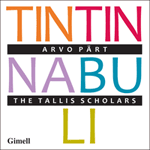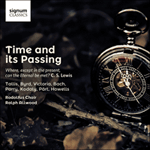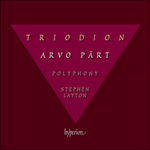
Welcome to Hyperion Records, a British classical label devoted to presenting high-quality recordings of music of all styles and from all periods from the twelfth century to the twenty-first.
Hyperion offers both CDs, and downloads in a number of formats. The site is also available in several languages.
Please use the dropdown buttons to set your preferred options, or use the checkbox to accept the defaults.

Pärt was indeed aware of the prevalence of partnered ‘Mag and Nunc’ settings elsewhere, and of the possible inevitability that he would set the Nunc dimittis in the future (though not consciously as a companion to the Magnificat). So he describes it as a happy coincidence—‘my wish, their wish’—that he was asked to write one for the Choir of St Mary’s Episcopal Cathedral, Edinburgh, and their director Matthew Owens. Twelve years after the Berlin Magnificat, this setting of three remarkable verses from Luke Chapter 2 was premiered in a cathedral Evensong during the Edinburgh Festival in August 2001.
It is a text just waiting to be set by a composer of Pärt’s sensibilities – one of serenity and tenderness, followed by transcendent, sparkling joy. The same still beauty that he achieved back in 1977 with the second part of Tabula Rasa, or the Stabat Mater in 1985, is present in the opening of this Nunc dimittis; and all three share the same stepwise downward sighs and intermingling dissonances of upper voices. In the equally placid ‘Gloria Patri’ (interestingly, Pärt’s Magnificat doesn’t feature this customary adjunct to the Evening Canticles), the two upper parts work against each other in stepwise ascent, then descent, around a contra-bass C sharp/G sharp pedal—playing with dissonance and consonance in the same way that Bach so often did. Centrally, Pärt prepares the ground for a radiant climax on ‘lumen ad revelationem’ (‘a light to lighten’) with a measured procession of gradually expanding phrases and anticipations of the brief, majesterial shift from C sharp minor to major.
from notes by Meurig Bowen © 2003
Pärt était effectivement conscient de la prévalence des réalisations dyadiques «Mag et Nunc» dans d’autres traditions, et de la possible inévitabilité d’aborder à l’avenir le Nunc dimittis (quoique pas forcément consciemment comme un pendant au Magnificat). Il décrivit donc comme une heureuse coïncidence—«mon désir rejoignant leur désir»—d’avoir été invité à en écrire un pour le chœur de la Cathédrale épiscopale Sainte-Marie d’Edimbourg et leur directeur musical Matthew Owens. Douze ans après le Magnificat de Berlin, cette composition élaborée sur des versets remarquables du Chapitre 2 de l’Evangile de saint Luc a été créée durant les vêpres chantées de la Cathédrale, à l’occasion de l’édition 2001 du Festival d’Edimbourg.
Il s’agit d’un texte qui, attendait précisément un compositeur de la sensibilité de Pärt pour être mis en musique. Un mélange de sérénité et de tendresse, suivi d’une joie transcendante et scintillante. La même beauté tranquille à laquelle il était parvenu en 1977 dans la seconde partie de Tabula Rasa ou dans le Stabat Mater en 1985 apparaît au début de ce Nunc dimittis: et tous trois ont en commun le même mouvement descendant conjoint aux allures de soupirs et des dissonances qui se mélangent aux voix supérieures. Dans le «Gloria Patri», également placide (à noter que le Magnificat de Pärt ne comprend pas cet ajout usuel aux cantiques des vêpres), les deux parties supérieures sont traitées de nouveau avec des dissonances et consonances d’une manière que Bach employait souvent. Au cœur de l’œuvre, Pärt prépare un apogée radieux sur «lumen ad revelationem» («Une lumière pour révéler») avec une procession mesurée de phrases qui s’élargissent progressivement et des anticipations de la modulation courte mais majestueuse de do dièse mineur vers do dièse majeur.
extrait des notes rédigées par Meurig Bowen © 2003
Français: Isabelle Battioni
Pärt war sich der Vorliebe für kombinierte „Mag and Nuncs“ [die in anglikanischen Kirchenkreisen weit verbreitete Abkürzung] in anderen Ländern wohl bewusst. Auch akzeptierte er die potentielle Unausweichlichkeit, in Zukunft den Nunc dimittis-Text musikalisch zu fassen (wenn auch nicht vorsätzlich als Begleitstück zu seinem Magnificat). Den Umstand, dass er vom Chor der St Mary’s Episcopal Cathedral in Edinburgh und seinem Direktor Matthew Owens gefragte wurde, ein Nunc dimittis zu komponieren, beschrieb Pärt deshalb als einen glücklichen Zufall—„mein Wunsch, sein Wunsch“. Zwölf Jahre nach dem Berliner Magnificat wurde diese Vertonung der drei bemerkenswerten Verse aus dem zweiten Kapitel des Lukas-Evangeliums in einem Evensong [anglikanische Abendandacht] der St Mary’s Episcopal Cathedral während des Edinburgh-Festivals im August 2001 uraufgeführt.
Der Text wartet geradezu darauf, durch einen Komponisten von Pärts Sensibilität vertont zu werden. Die Worte strahlen eine Gelassenheit und Zärtlichkeit aus, gefolgt von transzendenter, strahlender Freude. Der gleichen stillen Schönheit, die Pärt schon 1977 im zweiten Teil von Tabula Rasa bzw. 1985 in seinem Stabat Mater geschaffen hatte, begegnet man am Anfang des Nunc dimittis wieder. Alle drei Werke verzeichnen die gleichen abwärts schreitenden Seufzer und verschränkten Dissonanzen der hohen Stimmen. Im ebenfalls ruhigen „Gloria Patri“ (interessanterweise enthält Pärts Magnificat nicht diesen im anglikanischen Evensong sonst üblichen Anhang zu den Magnificat- und Nunc dimittis-Texten) arbeiten die zwei hohe Stimmen auf dem Hintergrund eines tiefen Orgelpunktes Cis/Gis zuerst abwärts und dann aufwärts schreitend gegeneinander, wobei hier wie so oft bei Bach mit Dissonanzen und Konsonanzen gespielt wird. Im Mittelteil bereitet Pärt mithilfe einer gemessenen Abfolge allmählich zunehmender Phrasen und durch Vorausnahmen des kurzen, majestätischen Schrittes von cis-Moll nach Cis-Dur den Boden für einen funkelnden Höhepunkt auf die Worte „lumen ad revelationem“ („ein Licht, das die Heiden erleuchtet“) vor.
aus dem Begleittext von Meurig Bowen © 2003
Deutsch: Elke Hockings
 Pärt: Tintinnabuli Pärt: Tintinnabuli“It is with great pleasure that we present our tribute to Arvo Pärt in his 80th year. Tintinnabuli (from the Latin for ‘bell’) is the compositional style created by Arvo Pärt which informs every work on this recording. In all my searchings for ins ...» More |
 Time and its Passing Time and its PassingThe Rodolfus Choir returns to Signum with a new collection of choral works drawn from composers spanning over 500 years.» More |
 Pärt: Triodion & other choral works Pärt: Triodion & other choral works |

